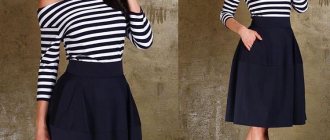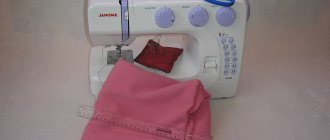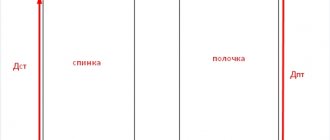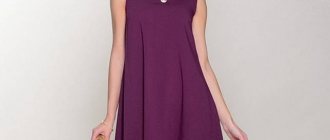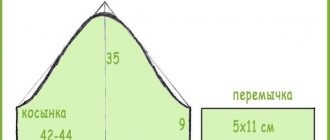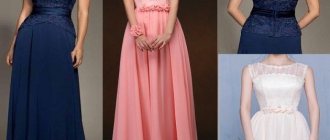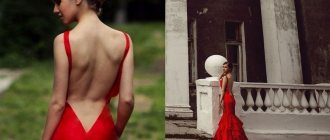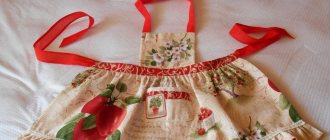Choosing an off-shoulder dress model
It is important to first decide whether both shoulders will be open or just one.
And is there any additional support at the free edge? We can divide the whole variety of dresses
- there are no straps;
- straps available;
- The straps are tied around the neck or intertwined.
Advice! If you have broad shoulders, then you should not get carried away with dresses in the “Carmen” style.
A wide frill and flounce can successfully replace straps for us.
Skirts can also be different:
- One-piece straight or slightly flared.
- Tatyanka, godet, sun or bell skirt, cut at the waist.
Topical fabrics:
- sewing;
- batiste;
- guipure, lace;
- crepe;
- chiffon, georgette;
- thin knitwear;
- thin stretch denim.
Colors and patterns:
- strip;
- floral prints;
- plain fabrics of rich colors - red, black, green, royal blue, light blue, ocher.
Advice! If you have a “pear” figure, that is, narrow shoulders, wide hips, then this style is definitely for you!
Pattern construction plan
Before creating a pattern, you need to take measurements. The model should stand exactly in the position that is most typical for it. At this time, the girl should only be wearing underwear. Measurements are taken at protruding points on the body.
Basic measurements that need to be taken for sewing:
- neck;
- breast;
- waist;
- hips;
- shoulders;
- the length of the sleeve;
- chest height;
- shoulder height;
- length of the product.
The sheath dress pattern is most easily constructed on graph paper.
Pattern No. 2
Pattern construction diagram:
- Draw a rectangular mesh, the height of which is equal to the length of the product. As an example, it is better to take a rectangular frame ABSD, where AB and CD are equal to the width of the dress, and AD and BS are the length. AB=SD= ½ chest circumference + 4 cm allowance.
- Divide the top half into three sections: back, armholes, chest.
- Back width = half the back width;
- Armhole width = 1/4 chest circumference + 3 cm allowance;
- Chest width = remainder.
- Create a neckline and shoulder line, as well as a dart for the shoulders. Neck width = 1/6 neck circumference + 1 cm allowance. It is recommended to raise the top by the amount obtained by adding 1/20 of the neck circumference and 1 cm. The shoulder line is drawn at an angle. It starts from the end of the previous step with a slope of 2.5 cm. On the inclined line, measure the length of the shoulder + 2 cm for the dart. Mark 4 cm from the neckline and make a dart 6 cm deep and 2 cm wide.
The neckline can be changed as desired. This will result in the product not being completely “pressed” to the neck, but located at a distance. The neck line should not be less than the dimensions that were measured. A shoulder dart is necessary because it will prevent the dress from looking like a hump at the neck. The cut will help ensure that the product fits tightly and easily to the figure and follows the curves of the body.
- Find the chest line. The lower border is located in the same place as the chest line. Armhole height = 1/8 chest circumference + 7 cm. This distance should be measured from the edge of the shoulder down. Measure the distance from the found line to the top edge of the main rectangle. Place the resulting value on the sides and connect with a line.
- Draw a line for the back and front armholes. The armhole line is directed downwards from the edge of the shoulder. You need to divide the height of the armhole by 3 and mark the beginning of the bend of the armhole. The height of the armhole from the front is 2 cm lower than from the back. Height = 1/8 chest circumference + 5 cm. The distance must be measured upwards. The edge of the armhole bends to the side by a distance = half the chest circumference divided by 10.
- Draw the neckline and chest dart. The bust line is the bottom edge for the armhole and bust dart.
- front neck width = 1/6 neck circumference + 1 cm;
- depth = 1/6 neck circumference + 2 cm;
- diagonal size = 1/6 neck circumference + 1 cm;
- the point of the edge of the neckline above the chest = a quarter of the chest circumference + 4 cm.
You might be interested in this. Everything you need to know about tailoring car interiors.
Ready product
- Connect the edge of the neckline to the edge of the front armhole. On the bust line, mark ½ of the bust center measurement + 1 cm = top of the bust dart. Bust dart width = shoulder line length - shoulder measurement.
- Separate the back from the front. The border is slightly shifted towards the back. Border = 1/3 of the width of the armhole area. The border of the shelves passes through a point located to the left.
- Draw the lines of the waist and hips, and also make a dart. The waist line is located along a segment drawn from the upper corner of the rectangle, the length of which is equal to the length of the back. Hip line = ½ back length. Back dart line distance = ¼ back width. Front dart line = continuation of bust dart.
The dart at the waist allows you to fit the dress evenly. The excess fabric is directed inwards when the edges of the dart are sewn together. The waistline allows the dress to be narrowed at the sides.
- Draw the extension for the hips. Mark 1.5 cm from the side line in two directions. Mark 3 cm on the bottom line and connect the dots.
- Transfer the drawing onto copy paper.
This sheath dress template is a pattern for beginners.
Calculation of suitable material
To sew a dress with open shoulders, we will need an amount of fabric equal to its length, plus a hem allowance of 10cm, plus the length of the frill or flounce. This is true for a fabric width of 140-150 cm.
With a smaller width, we need double the length. If your dress has sleeves, then add their length.
Instructions for use
You can make a similar dress yourself. The stores sell a large number of simple, minimalistic models that would not hurt to decorate with an elegant frill. Purchase fabric of the required shade from a sewing boutique and sew it to the product. We talked about the features of the cut in one of the first sections of the article. If you want the shuttlecocks to be soft and smooth, make a large radius of the inner circle.
Popular articles Wooden wall clocks: characteristics and review of the best models
For a walk
As for the style, you should be guided by the parameters of your own appearance and age. For example, young ladies with slender legs can afford a sexy mini, while older ladies are more likely to be more suited to discreet and elegant midis. For special occasions, you should purchase a floor-length satin robe.
Now it's the turn of the shoes. Beach and casual dresses are usually complemented with stylish flat sandals. You can also wear ballet flats if they do not have massive decoration on the toe.
For work, you can buy elegant pumps. With a small heel you will not feel tired, and its length does not contradict the strict rules of the dress code. In the summer, actively use sandals with a closed toe - this way none of your colleagues will see your pedicure.
Fashionable check
Feel free to use different accessories. A stylish bracelet on your wrist, sunglasses, a small handbag - this is something that any self-respecting fashionista should definitely have in her arsenal.
What about the cold season? Autumn is ahead with the first frosts, and then the frosty winter months. It's time to think about warm clothes. A dress made of light knitwear is considered the most successful solution. It goes well with fur coats, sheepskin coats, cropped jackets, trench coats, drape coats and even down jackets. Feet can be wrapped in leather boots with high, stable heels.
Perfect option
Airy and easy
The dress has always been an invariable attribute of a woman's wardrobe. Only it can amazingly transform your appearance, hide all the shortcomings and highlight the advantages. And such a trend as flounces was specially created in order to enhance girlish charms and make the image even more feminine and sexy. And don't forget about taking care of your skin. The décolleté area almost always remains open, and any pimple in the chest area can completely ruin the impression of you.
Cutting off-shoulder dresses
If the cut is asymmetrical, then we cut only on fabric laid out in one layer.
- We fold the material in half, face to face (with a symmetrical arrangement of elements).
- Lay out the pattern pieces on the prepared fabric.
- We shallow it, not forgetting the seam allowances.
- Cut it out.
Important! We first check on a small piece of material to see if it is fading or shrinking.
Ready-made patterns
For those who do not want to spend time creating patterns, there is a quick way with ready-made templates. Options may be different: product length, presence/absence of sleeves, sleeve length. On the Internet you can find a large number of different sheath dress patterns and choose the best option for yourself.
You may be interested in: Simple patterns of travel pillows for your car yourself
Important! When sewing, it is important to know your size, so it is recommended to use European size tables. You need to measure your own height, hips, waist and chest and choose the appropriate size.
Pattern No. 1
Sewing sequence
Required:
- Dress fabric according to calculations.
- Bias tape.
- Threads to match.
- Sewing machine.
Progress:
- We process darts, if any.
- We sew the back seam (if it is supposed to be in this model).
- Iron the seam allowances. We perform this procedure with each seam.
- We turn the drawstring and stitch it.
- We sew the front seam.
- Sew the side seams.
- If the skirt is stitched, then we sew the seams of the skirt, then sew it to the top.
- We bend the hem and stitch it.
- We process the cuts with bias tape, if necessary, use facings.
- We thread a lace or elastic band into the drawstring.
- Ironing.
- Let's try it on.
When making an off-the-shoulder dress, of course, you have to spend time, but the result is worth it.
In addition, this style offers a wide range of options, which is good news. Knitted mohair hat
How to felt a pig out of wool for beginners
How to make a frill
There are several ways to cut and sew a frill for the bottom of a dress. The following describes how to sew a flounce to the bottom of a dress in more detail.
For these purposes, you can use a frill cut in the form of a ring. In this case, the lower part will be wavy. How to sew a frill to the bottom of a dress: its inner part is attached to the bottom of the main part of the dress. Since the outer side of the flounce is wider, it will go in waves, giving the impression that the frill is flowing.
Various styles
A similar method is cutting in the form of a spiral.
You can make a flounce for a woman or girl by taking an even strip of fabric of the required width. However, it must be hemmed to the main part of the dress in a special way.
To do this, you need to act in accordance with the step-by-step instructions:
Shuttlecock assembly
The shuttlecock is folded into a ring. It is necessary to mark its middle. Make two seams along the edge with a wide stitch
This requires that the threads come out on both sides of each seam. It is important to ensure that the size of one part of the frill thus obtained matches the length of the back, and that of the other - with the front, taken along their lower edge. The threads need to be slightly tightened. In this case, it is necessary that the fabric in the form of a half-sun is positioned evenly. The frill should be basted onto the lower sections of the main part of the dress.
After that, it is attached and an overlock is done on the cuts.
Shuttlecock processing
The frills of the flounce cannot be ironed, because this will smooth out the folds on the skirt and the frill will lose its special, romantic look.
Shuttlecock attachment point
Important! You will need to make a double fold along the bottom edge. It can be sewn on a machine or done by hand using a blind seam
The allowances will need to be cut off. This is necessary to ensure that the thickness of the fabric does not become excessive.
Sometimes an elastic band is used in the shuttlecock.
A dress with a ruffled bottom is suitable for those women who want to emphasize that they are special. In this case, you need to carefully ensure that the figure matches this style. It must be remembered that the frills located at the bottom increase the visible volume of the hips and at the same time should emphasize the advantages of the figure. There are a large number of dresses with frills at the bottom, among which many women will find the most spectacular.
